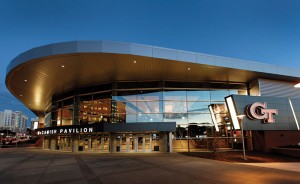KSi/Structural Engineers was an Award Winner for the McCamish Pavilion project in the 2013 NCSEA Annual Excellence in Structural Engineering awards program (Category – Forensic/Renovation/Retrofit/Rehabilitation Structures).
The McCamish Pavilion is the home of the Georgia Tech Yellow Jacket basketball program and has been a part of the Georgia Tech Community since 1956. The original facility included a 50-foot tall, 270-foot diameter, 32 rib structural steel Schwedler dome over a 25 foot deep, cast-in-place, circular concrete bowl. Several renovations and additions have been performed over the life of the facility. Georgia Tech’s goal for this renovation was simply to improve the fan experience in the arena. Desired improvements included better sight lines, increased seating row depth from front to back, a circulation concourse open to the court, modern audio visual equipment including a center hung scoreboard, an improved HVAC system, an enlarged circulation concourse and compliance with current building codes.
To improve sight lines and address seating row depth issues, a new octagonal seating bowl design was developed. The original bowl was demolished and a new cast-in-place concrete bowl installed at grade. The new octagonal bowl design eliminated approximately 2,000 seats. To replace these lost seats, a new upper deck was installed within the existing Schwedler dome. The upper deck utilizes elevated flooring supported on structural steel raker beams which are in turn supported on curved structural steel struts.
Traditional materials for elevated arena seating floors include precast concrete and folded steel plate, but neither of these materials was optimal due to the capacity of the existing structure. The precast concrete option was simply too heavy and overstressed the existing steel dome ribs. The layout of the upper deck made it desirable to span the upper deck riser system from existing rib to existing rib, on the order of 25 feet. Folded steel plate could not span this far without the addition of significant secondary framing. A new material, the Sandwich Plate System, SPS, was investigated and selected for the flooring system. This composite flooring system was originally developed for the offshore and shipbuilding industry. The SPS system includes two ¼-inch steel plates at the top and bottom of the assembly infilled with a polymer resin layer on the order of 1-inch thick. The McCamish Pavilion installation is the first onshore use of the SPS material in the western hemisphere.
The SPS system cannot be field cut or welded; it has to fit perfectly the first time. Innovative point cloud technology was used in the design, fabrication and installation of the upper deck structural steel and SPS. A three dimensional map of the upper deck was developed by inserting a laser scanned point cloud survey of the existing steel into the 3D BIM model of the new structural steel components. All of the structural steel and SPS components were fabricated from this model. The method was so precise that all pieces fit without shimming, trimming or other modification upon installation.
The raker beams supporting the SPS are attached to the existing Schwedler dome for lateral stability, and balanced on curved struts to limit the gravity load introduced to the existing framing. New foundation systems to support the struts were also challenging. The location of the facility over an abandoned landfill, and thrust loads from the new upper deck, required the use of battered deep foundations. These deep foundations were installed from the sloped side of the existing bowl underneath the existing steel ribs, resulting in a low headroom condition on a working platform sloped at 30 degrees. Because of the installation conditions, steel pipe micro piles were utilized for this application.
The addition of the other fan amenities also posed structural challenges for the project. The audio visual, lighting, and HVAC components all added significant load to the Schwedler dome. A three dimensional analytical model of the facility was developed to study the effects of added loads from new audio, visual, lighting and HVAC components. The added load significantly overstressed the existing building ribs. To mitigate the effects, connections of existing secondary roof members were modified to resist increased tension loads, converting the secondary members into tension rings. In the review of the existing documentation, it became evident the existing facility had no discrete lateral load resisting system. To bring the existing structure into compliance with the current building code, a new lateral load resisting system within the existing dome structure was required. New structural steel V brace frames were selected because they were the least intrusive applicable system. The new frames were “woven” through existing steel, changing the planar angle of the brace at each level to reduce impacts to seating counts and sight lines.
To limit lateral bracing locations, supporting the need for unobstructed site lines, all lateral loads were transferred from the new circulation concourse to the dome bracing through the use of roof diaphragms and collector elements. Conversely, the amount of gravity load the new concourse framing transferred to the existing structure had to be limited to avoid overstressed conditions in the existing dome ribs. The layout of the concourse framing was developed to achieve these goals.
The look and feel of the arena was completely changed by the renovation, transforming an aging facility from the 1950s into a twenty-first century arena. The renovation would not have been possible without the innovative structural materials, assemblies, and construction techniques developed by the project team.▪

